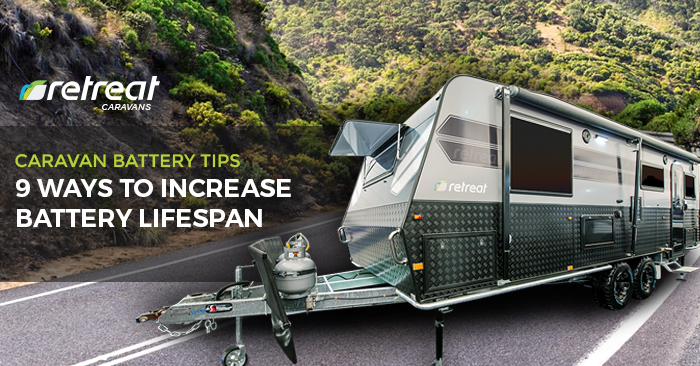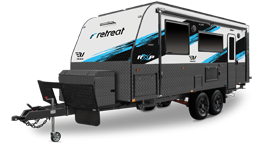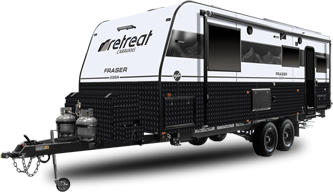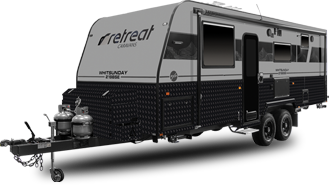
Caravan Battery Tips: 9 Ways To Increase Battery Lifespan
There are three types of caravan batteries, namely flooded, absorbed glass mat (AGM) and gelled electrolyte.
Often termed leisure battery, a caravan battery is used to power your appliances when your caravan is not hooked to an electrical source. It provides stable power for appliances like your TV long after the caravan has been unhitched.
Further, caravan batteries support the current flow from caravan chargers.
The longevity of a caravan battery depends on how well you maintain it. It doesn’t help that brand new batteries which are supposedly fully charged is only charged to 60% to its capacity.
Tips on how to check the battery lifespan and conduct maintenance
The biggest misconception among amateur caravanners is that car and caravan batteries have the same function. A car battery provides high power at once enough to start the car. On the other hand, a caravan battery is designed to dissipate steady power over a prolonged period to power multiple appliances.
1. Avoid draining the battery
Every caravan battery is designed to provide a specific number of deep discharge cycles. Depending on your type of battery, you can achieve 20 to 300 cycles (Flooder or Cheap), 400 to 500 cycles (gel) or 600 to 800 cycles ( AGM), while batteries with 5-year-guarantee give 1,000 cycles. Whenever your battery charge falls below 75% re-charge it; never let it level fall below 50%.
Ideally, you must check your caravan battery charge every two months and avoid running it flat off charge, as it damages the battery performance too.
2. Batteries of identical capacity in a series, identical voltage in a parallel connection
When you connect your battery in a series connection with the positive terminals to the negative terminals, you increase total voltage produced by the battery. On the other hand, connecting the positive-to-positive and negative-to-negative terminals will increase the total current.
To maintain the battery capacity for long-term, connect batteries of identical capacity in series and identical voltage in parallel.
3. Use a Voltmeter
Using a digital voltmeter, you can ensure that your battery is charging and discharging power appropriately. A voltmeter can also be used to test the voltage of your appliances to ensure that there is no leak. Furthermore, remember to let your battery rest for a few hours after charging it, as fresh readings are often wrong. It is recommended that you take voltage readings of freshly charged caravan batteries not before 6 hours.
To analyze the status of your battery at different strengths, refer to the chart with the use of a voltmeter –
Voltage |
Charge |
|
12.6 and above |
100% |
|
12.5 |
90% |
|
12.42 |
80% |
|
12.32 |
70% |
|
12.20 |
60% |
|
12.06 |
50% |
|
11.90 |
40% |
|
11.75 |
30% |
|
11.58 |
20% |
|
11.31 |
10% |
|
10.5 |
0% |
4. Beware if your Battery Stinks
Another significant sign of a malfunctioning battery is that it emits a rotten egg odour. This is the smell of sulphur gas when the battery is overcharged. To check if the battery was overcharged, touch it . If it feels burning hot, disconnect immediately from the power supply before the battery is totally wrecked!
Don’t ignore the stale smell. This is a sign of leaked gases, which can lead to ignition. Always keep the temperature of your battery in check when recharging.
A word on overcharging: sudden overcharging also drains the liquid topping permanently in a sealed battery. While a non-sealed battery can be topped up even after repeated overcharging, this practice shortens its long-term performance.
Tips on how to increase make your caravan’s battery last long
Most caravan batteries are made to last 5 years, provided you maintain it well. To maximise the power from your caravan batteries, ensure that you use a viable charger. Your charger must have an output of a minimum of 10% of your battery capacity. Ergo, an 80 Ah battery will require a charger of 8 A.
Here are other techniques to maintain your battery properly
Limit the use of equipment that requires a lot of power
A caravan battery demands regular usage or smart storage when not in use. In order to extend the lifespan of your battery, avoid using equipment like TV and microwave. These appliances drain power fast and all of a sudden. Regularly using such appliances leads to erratic and fast battery discharge. When this happens, you would need to recharge the battery more often, leading to faster deterioration.
If it is necessary for you to use high drain equipment, use a battery that can take the load too.
2. Annual Inspection and Cleaning
Unplug the vents of a non-sealed battery to check the battery cells individually and if it needs topping with distilled water. For sealed batteries, you can skip this step. Every caravan manufacturer recommends cleaning your battery with petroleum jelly.
Clean the battery tray, terminals as well as the connectors, in addition to coating the connectors with petroleum jelly. Make sure you inspect the battery every two months and clean it annually, including the tray to maximise its lifespan.
3. Switch off appliances when not in use
If you have a habit of leaving your appliances on even when not in use, your battery life is under threat
Constant discharge of power also leads to erratic discharge levels such as under charging or overcharging when you use an appliance while recharging. Regardless of the lower or higher power of an appliance, if there is a constant discharge, the performance and lifespan of the battery depletes.
4. Topping Up Routine
Avoiding the use of tap water is necessary when filling batteries that require liquid top ups. In fact, for even the cheapest of caravan batteries, sensitivity to variable voltage is enhanced when periodically topped up. When there is no topping liquid available, a battery degrades faster. When your battery hits 0% charge and remains uncharged for more than 7 days, it becomes sulphated or simply put, useless. Sealed batteries do not require topping.
5. Caravan Storage
For people other than full-time caravanners, it is necessary to store the caravan well if you are not planning to use it for winter. For the battery, disconnect it only after it has been fully charged and never leave it fully drained. Avoid storing the battery directly on concrete as these adds to the deterioration. In addition, make sure you recharge the battery every 1-2 months when in storage.
You can also use a trickle charge to stabilize the power level when you’re about to use it after a long time of storage. Modern batteries lose power at a rate of 0.1%-0.2% at room temperature when not in use.
Conclusion
If your battery does not provide power for more than 20 hours, it is faulty! Apart from improper use, there are additional factors that adversely affect the longevity of a caravan battery. While in winter (lesser than 25 0C), caravan batteries take longer to charge and loses 1% power respective to every degree that temperature that goes down.
Hope this caravan battery tips will guide and understand you more about your caravan batteries. Check out 2017 Retreat Caravans new caravans for sale.












